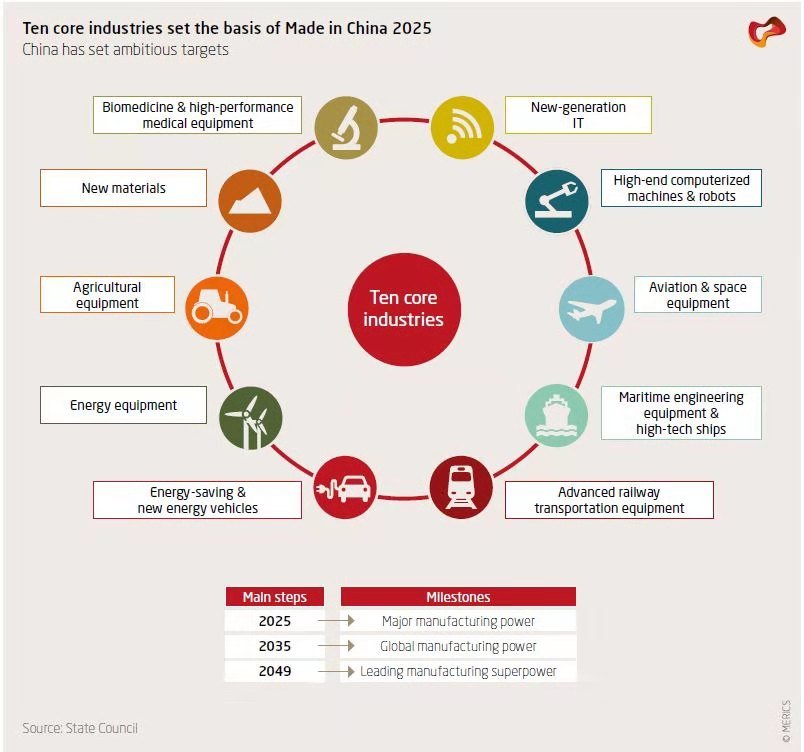Chinas Grand Strategy – “Made in China 2025” (MIC25)
By end of 2018 the "Made in China 2025" (MIC25) strategy was implemented by the Chinese government - But what does it say?
Chinas ambitions to be a worldwide leading industrial nation by 2049. See what Made in China 2025 involves and why this is so important to understand.
Even with a lot of internal discussions and international criticism, China pushed by end of 2018 for their new industrial strategy “Made in China 2025” or short MIC25.
It is a huge commitment of the Chinese government to ensure that China will be a leading industrial superpower by mid of this century. For this, the Government has defined 10 different industry-focus areas, 9 different strategic objectives, and 5 initiatives that will be implemented nationwide. But what is the final goal? The Government plans to present China as a leading Industrial Superpower for its 100th anniversary which will be in 2049. By then it wants to make sure that it has the capabilities to produce leading technologies, innovations, and industrial systems.
The nine strategic tasks are as following (Source: China-Britain Business Council)
- Encourage Innovation
- Promote the use of integrated, digital, and technology-focused manufacturing
- Strengthen the overall industrial base
- Improve product quality and build global Chinese brand names
- Focus on enforcing green manufacturing methods
- Make innovative technological breakthroughs in the 10 focus sectors
- Restructure industries to improve efficiency and output
- Improve service-oriented manufacturing and manufacturing-service industries
- Globalise Chinese Manufacturing Industries
Index
Goals for 2025, 2035 and 2049
China placed 2 milestones until 2049. The first one will be in 2025 where the government wants to make sure that the industry is capable of producing higher qualities. The goal is that “Made in China” has a good reputation for industrial production. The cheap and low-quality times of Chinese industries should be over soon.
In the second wave, China wants to position itself in the middle field of the leading industrial nations. This also involves the mission to be more energy- and resource-efficient, be more sustainable but also involve more innovative technologies in the production.
By 2049 the overall goal should be met that china is the leading industrial nation in the world. By then they want to take a worldwide leader in the 10 defined industry areas.
- New-generation IT
- High-end computerized machines & robots
- Aviation & Space equipment
- Maritime engineering equipment & high-tech ships
- Advanced railway transportation equipment
- Energy-saving & New energy vehicles
- Energy equipment
- Agricultural equipment
- New materials
- Biomedicine & high-performance medical equipment

5 big strategic initiatives
The Chinese Government implemented 5 nationwide initiatives to implement a strategy where already major milestones are completed in 2020.
1. Research and Development Centers

China implemented 15 R&D centers until 2020 and in total 40 of these Research&Development centers will be implemented by 2025. These centers are dedicated to the development of key technologies and cutting edge innovations for the 10 defined industry areas.
Here you see a map of the currently planned and implemented R&D centers, especially around manufacturing technologies.
2. Development of High-End Projects in key industries
With the basis of the R&D centers but also in cooperation with the industry, the government plans large scale innovation projects for high-end industries.
The overall goal is to ensure that China increases its market share for the important sectors and also produces Intellectual Property for these key industry areas.
3. Green Manufacturing / Sustainable Production
As we heard in the news quite often, the Chinese Government is pushing hard towards sustainability and green industry. One of the major objectives is to save the environment and make sustainable production possible. Until 2025 the energy efficiency of the Chinese manufacturing industry should be equal to or lower than the most advanced international standards.
4. Smart Manufacturing
It is key to have Chinese companies investing in smart manufacturing models, robotics but also digitalization. The goal was to decrease the production cost and time by 30% by 2020 and 50% by 2025.
5. New Materials
The last initiative focuses a lot on the basic commodities. In 2020 china wanted to be able to provide more than 40% of the core materials and components from the own market. The goal will be to increase this number for these important industrial materials for all the key industries to 70% by 2025.
What does it mean for the rest of the world?
This strong commitment by the Chinese government shows the will to really change the image of China. They want to focus on innovation, green technologies, and also take leadership for more industry areas of the future. The massive investments, Pilot Cities, The “One Belt, One Road”-Initiative, and many more investments level the field for the way to chinas industrial supremacy.
The USA already said that this will be a real existential threat to the technological leadership of the USA. But we also saw that Europe is struggling in the last years to create a common strategy and an innovation ecosystem. This will lead to more intense international competition in the innovation space.
Also looking into the start-up market we see a clear picture of where the innovation is happening currently. CB Insights published the Unicorn List (Start-Ups valued over 1 Bio USD) and while Europe only accounts for some dozens Unicorn-Start-Ups the US leads with 228 and China comes in second at 122.
This leads us to the question: Where should companies go and invest in their R&D when China wants to become a leading industrial and technological hub in the world?

Comments are closed.